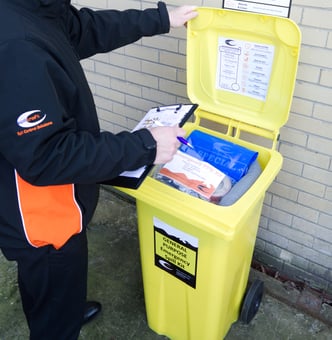When completing a spill risk assessment, you’ll need to take into consideration what materials...
Do your spill kits get used and not replenished?
Do your spill kits get used and not replenished? It’s more common than you may think. However, it is critical spill kits are maintained to ensure you are compliant and prepared for spill emergencies.
Your spill response plan has highlighted that you need an emergency spill kit in a specific area, for a potential spill hazard, so that kit needs to be maintained in case of a further spill.
If a spill kit hasn't been replenished after a spill, several issues could arise, potentially leading to serious consequences: 
-
Inability to Respond to Future Spills:
- Safety Hazards: Without the necessary materials, you may be unable to effectively contain and clean up future spills, leading to slips, falls, or exposure to hazardous substances.
- Environmental Damage: A lack of proper materials could result in spills spreading, potentially contaminating the environment, such as soil, water sources, or local wildlife.
-
Regulatory Non-Compliance:
- Fines and Penalties: Failure to have adequate spill response equipment on site can lead to fines, penalties, or other legal consequences during inspections or audits.
- Operational Shutdowns: In severe cases, non-compliance can result in a temporary shutdown of operations until the issue is resolved.
-
Increased Risk of Escalation:
- Larger Spills: Without the appropriate materials to quickly manage a spill, even minor incidents can escalate into larger, more difficult-to-control situations, leading to more significant damage or hazards.
- Spread of Contaminants: If a spill isn’t contained quickly, hazardous materials could spread to other areas, exacerbating the clean up effort and increasing the risk to personnel and the environment.
-
Health and Safety Risks:
- Exposure to Harmful Substances: Employees may be at greater risk of exposure to harmful chemicals or substances if they cannot properly clean up a spill, leading to potential health issues.
- Slip and trip hazards: If the spill kit isn't replenished, a spill may be left unattended, leaving a slip risk for any passers by.
-
Damage to Equipment and Property:
- Corrosion or Contamination: Spills left uncontained can cause damage to equipment, machinery, or property, leading to costly repairs or replacements.
- Operational Delays: Damage to critical equipment or areas might lead to operational delays, impacting productivity and potentially leading to financial losses.
-
Increased Clean up Costs:
- Professional Clean up Services: If the spill isn't contained properly due to a lack of supplies, you may need to hire external professionals to handle the clean up, which can be costly.
- Waste Disposal Issues: Improper handling of spills can lead to complications in waste disposal, resulting in additional expenses or regulatory issues.
-
Reputation Damage:
- Customer and Partner Trust: If word gets out that your organization cannot properly handle spills, it could damage your reputation with customers, partners, and stakeholders.
- Employee Morale: A lack of preparedness can affect employee confidence in the organization’s commitment to safety, leading to lower morale and productivity.
Ensuring that spill kits are replenished after each use is critical to maintaining a safe, compliant, and efficient working environment.
So what is the solution? 
Managing spill kit replenishments effectively can be straightforward with the right approach. Here are some easy ways to ensure your spill kits are always fully stocked:
- Designate a Person or Team to manage the process
Assign a specific individual or team the responsibility of checking and restocking spill kits regularly. This ensures accountability and consistency. - Routine Checks: Establish a regular schedule (e.g., weekly or monthly) to inspect spill kits and check inventory levels. Mark it on a calendar or use reminders to ensure it's done consistently.
- Checklist: Create a simple checklist that outlines all the items that should be in the spill kit. Use this checklist during inspections to quickly identify what needs replenishing.
- Tracking Supplies: Use a basic inventory management system, , to track the use of spill kit supplies and the need to reorder replenishments.
- Visual Indicators: Use audit tags and/or audit covers on spill kits to indicate that they have been replenished. If the seal is broken then it needs checking.
- Easy Access: Include simple instructions inside each spill kit on how to reorder supplies. This can make it easier for whoever uses the last of a supply to take immediate action.
- Awareness and Action: Train employees on the importance of spill kit maintenance and encourage them to report when supplies are low or used. This creates a culture of shared responsibility.
- Keep a stock of replenishment supplies: Create a designated area where extra spill kit supplies are stored. Label it clearly so employees know where to find replacement items quickly.
- Refill kit convenience: Some suppliers offer pre-packed refill kits that contain everything you need to restock a spill kit. Keeping a few of these on hand can make replenishment quick and easy.
By implementing these simple strategies, you can ensure that your spill kits are always ready for use, minimizing the risk of being unprepared for spills.
Looking for additional support?
If you need support in maintaining your spill kits regularly, there are options available for outsourcing this such as our Spill360 programme. Designed to free up Health, Safety and Environmental teams giving you the opportunity to focus on other tasks, Spill360 can take away the hassle of managing your spill equipment and replenishments.
You can find out more about Spill360 here or call our friendly team to discuss your requirements on 01606 352 679

.jpg?height=200&name=2%20Spill%20kits%20not%20maintained%20to%20correct%20spec%20(1).jpg)

